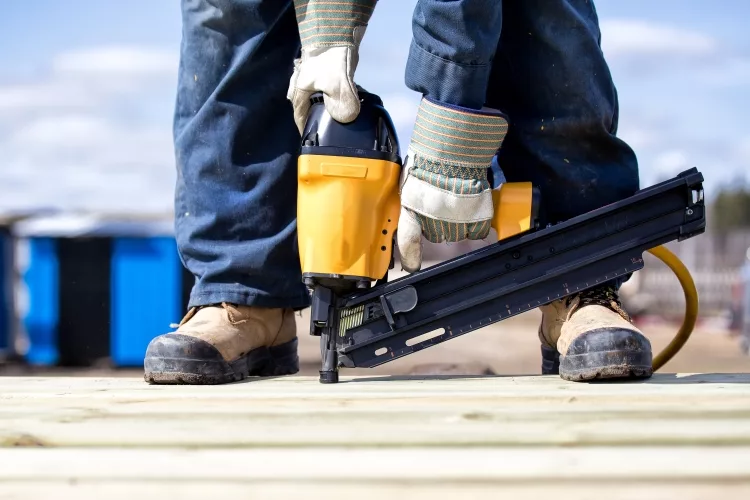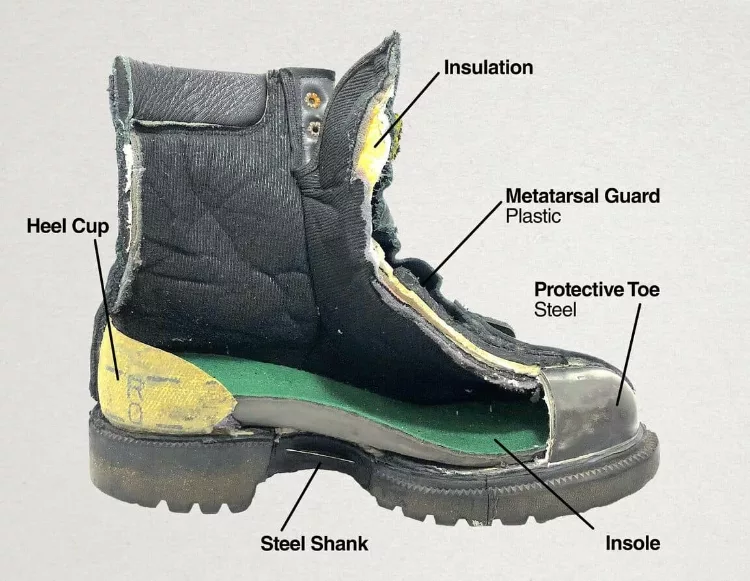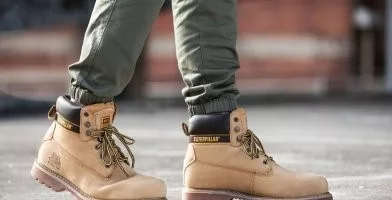Steel Toe Vs. Composite Toe Work Boots
by Jason Flores
Safety-toe footwear is required on numerous construction sites and in many buildings. According to OSHA, employees should wear that footwear that provides complete protection while working in certain places with a high risk of foot injury caused by falling items.
Steel-toe boots are a popular choice, but there are still nonmetallic alternatives, such as composite-toe boots with protective toe coverings made of plastic, carbon fiber, or other durable synthetic products.
Steel toe and composite boots are both made to keep your feet safe. But how are you expected to make a decision between them?
You must first grasp their distinctions to make the best option. We're here to assist you!
Contents
- Steel toe boots
- Composite toe boots
- Summary Table for Composite toe boots vs Steel toe boots
- Conclusion on Steel Toe Vs. Composite Toe Work Boots
- Frequently Asked Questions (FAQs)
- Is it true that composite toe boots are OSHA-approved?
- Which is more durable: steel toe or composite toe?
- What does ASTM comp toe mean?
- What's the difference between steel and alloy toe footwear?
- Is it possible for steel toe boots to create foot problems?
- What is the maximum weight that a composite toe boot can bear?
Steel toe boots:

As the name indicates, steel-toe boots consist of a steel bar at the bottom of the foot to give excellent protection. Steel toe footwear, of course, complies with ANSI safety standards. And besides, they're meant to protect the toes of:
- Electricians
- Construction workers
- And others who operate in dangerous conditions.

Sadly, some of these workers must pass via screening regularly, which may include metal detectors. Steel toe work boots contain metal that can set off metal detectors, causing inconvenience and possibly squandering time. Steel toe boots are therefore an excellent alternative if you do not need to pass through metal detectors.
The ability of safety shoes to shield the feet from sharp items that can puncture them is known as puncture protection. Steel toe boots are only superior to composite toe boots in terms of puncture resistance when compared to composite toe shoes. On the other hand, composite shoes have so much more to give than standard steel-toe boots and thus are more costly.
Because the toe cap is made of metal, it has low electric and heat resistance. It may bring tiredness to the joints of the feet and legs because it is the heaviest.
Composite toe boots

Composite toe boots are more lightweight than steel toe boots and do not include any metals. Conversely, the toe component of the footwear is made of a composite material. Kevlar, polyester, and carbon fiber are just a few examples of composite materials. Compared to boots without a safety toe, composite toe boots surpass the ANSI safety regulations for shoes designed to provide additional protection to your toes.
Composite toe boots, on the other hand, are often preferred by people who must pass through metal detectors, such as:
- Nuclear employees
- Security personnel.
- Airport workers
Composite boots are nonmetallic; they do not turn off metal detectors like steel-toe boots.
When searching for steel toe or composite toe boots, there are two things to keep in mind:
- Impact ratings.
- Compression ratings.

The impact rating is a statistic that indicates how many pounds of impact the shoes will withstand. A pair of boots with an I/75 impact rating, for example, can withstand a 75-pound impact.
A weight is thrown from a set height at a particular speed onto the boots to calculate the impact rating. The shoes are branded I/75 if they can handle a 75-pound weight. (This isn't something we'd want to volunteer for!) I/50 is the lowest impact rating for safety toe boots.
The number of loads the shoes can endure before shattering or tearing is known as the compression rating. A C/75, for example, can withstand compressive stresses of up to 2,500 pounds. Compressive loads of up to 1,750 pounds can be protected by a C/50 pair.
Composite-toe safety shoes are newer than steel-toed safety shoes and have been introduced much later. They are nearly 30% lighter, and in some cases, much more so than their traditional equivalents. It is composed of various nonmetals that provide higher strength and resistance when fused together to form some other compound.
Steel-toed safety shoes have been around for a long time and were preferred for work boots until composite toe boots were developed. This term is based on the fact that the toe cap of the shoes is composed of steel to protect the feet from injury. It weighs between 1.2 and 2 kg.
Your employment will almost certainly play a role in deciding between steel toe and composite toe choices. Here are some considerations to consider when you make your decision:
- Will you have to walk through metal detectors frequently?
- What kinds of threats will you encounter on the job?
- What is the weight of the equipment that could fall on your feet?
- With what standard of security do you feel most at ease?
- Are you frequently on the move, and could you benefit from a lighter design?
Answering these questions can assist you in making the best decision possible!
Summary Table for Composite toe boots vs Steel toe boots
Comparison : | Composite toe boots | Steel toe boots |
| Convenience: Consider footwear that uses the most sophisticated materials for its sole, top, and insulation if you're seeking work boots that give protection in a lightweight package.) (Take, for example, the sole. The heavy duty sole accounts for a large portion of a work boot's weight, according to Industrial Safety & Hygiene News (ISHN). Likewise, the upper and insulation materials used in the boot might add or remove ounces. | Because of their reduced weight, composite-toe safety shoes are more comfortable to wear. | Because they are more rigid, steel-toed shoes are less comfy than their counterparts. |
Weather-friendly:
| Composite ted shoes are the ideal work shoes for cold weather since they are more insulating. | As a result, because it is constructed of metal, it provides no insulation and is therefore unsuitable for cold weather. |
| The price | Shoes with composite toes are more costly than those with steel toes. | When compared to composite toes, steel-toed shoes are less costly. |
| How do they look physically? | Composite toe shoes are hefty because they have more area in the toe box. | Steel toe shoes are less hefty because they have less area in the toe box. |
| Resistance to electric current | It has a high electrical resistance because it is composed of nonmetals. | It has a low electrical resistance because it is constructed of metal. |
| Suitable for metal | Shoes with composite toes are made of nonmetallic materials. As a result, metal detectors aren't triggered. | Shoes with steel toes are constructed of metal. As a result, metal detectors are triggered. |
Conclusion on Steel Toe Vs. Composite Toe Work Boots
Safety toes (Steel Toes, Alloy Toes, and Composite Toes) are changing and improving. The likeness of Composite Safety Toes is undeniable. The newly developed Graphite Fiber Safety Toes (the New Era Composite Toes) is composed to gain massive adhesion in the Safety Shoe industry.
Either they are constructed of steel or composite material, the toe cap in ASTM-compliant safety-toe footwear will provide enough protection.
It's safe to infer that composite toe safety shoes are superior to steel toe safety shoes. It offers most of the features that are desired in a worksite safety boot. However, they are more costly, and some people prefer steel-toe work boots for this reason. Both of them provide roughly the same level of protection. As a result, the shoes can be purchased by the climate in which they will be used.
Every time you select work shoes, consider the work environment and the type of task the employee will be doing. You must double-check that the footwear you choose complies with the necessary safety criteria.
Frequently Asked Questions (FAQs):
Is it true that composite toe boots are OSHA-approved?

OSHA Approved Composite Toe Boots? OSHA and ASTM safety standards are met by composite toe boots. They are electrically resistant. Engineers, electricians, and certain independent contractors choose composite toe boots.
Which is more durable: steel toe or composite toe?

Steel and several alloys are stiffer than synthetic materials, allowing Steel Toe Safety Shoes to be slender and have a relatively low profile (less bulbous) while still passing the ASTM Safety Toe tests.
What does ASTM comp toe mean?

Whether constructed of steel or composite material, the toe cap in ASTM-compliant safety-toe footwear will provide enough protection. Safety footwear that meets ASTM standards is labeled with a designation that indicates the threats it has been assessed for.
What's the difference between steel and alloy toe footwear?

Alloy toe safety boots have been getting very popular nowadays. The only significant distinction between them and steel is the materials and components used in construction. Alloy toes are composed of lightweight materials such as titanium, aluminum, or a fusion of these and other light materials.
Is it possible for steel toe boots to create foot problems?
Bunions, which are bony growths on foot, can also be caused by too-small shoes. Steel toe work boots are commonly blamed for these problems, but it is actually ill-fitting boots that are to blame. To put it another way, it changes the shape of your feet! Steel toe work boots that are correctly fitted pose no concerns.
What is the maximum weight that a composite toe boot can bear?
What is the maximum weight that composite toes can support? Composite toes, in fact, can keep the same amount of weight as steel toes. It can help up to 1.1 metric tonnes of weight.
 |
 |
 |
 |

About Jason Flores
Jason Flores is a multi-talented individual whose unique journey has led him to blend his passion for craftsmanship and fashion into a creative endeavor. During his formative years, he found himself immersed in the world of handiwork, spending countless hours in his grandfather's workshop. These early experiences allowed him to develop a deep understanding of practical skills and a keen eye for detail.
Simultaneously, Jason harbored an innate love for fashion, drawn to the artistry and self-expression it offers. As he grew older, he recognized the potential to combine his proficiency in craftsmanship with his fashion sensibilities. This realization led him to a path where he began to explore and write about the intersection of fieldwork fashion.
Thoughts on "Steel Toe Vs. Composite Toe Work Boots"
 |
 |
 |
 |
Get FREE Boots Gifts now. Or latest free toolsets from our best collections.
Disable Ad block to get all the secrets. Once done, hit any button below
 |
 |
 |
 |